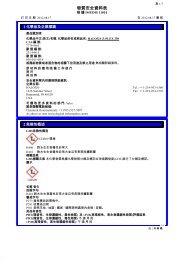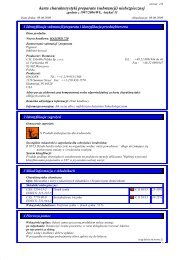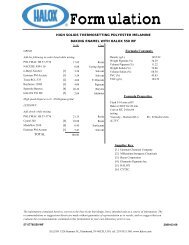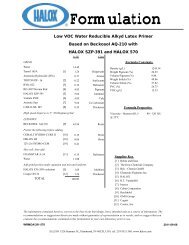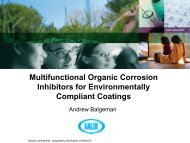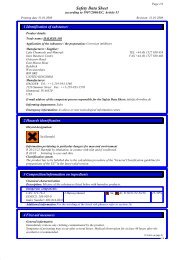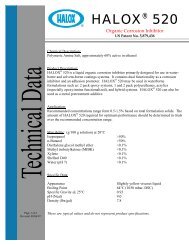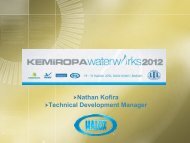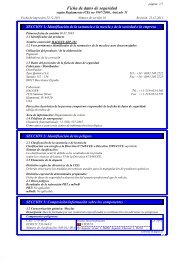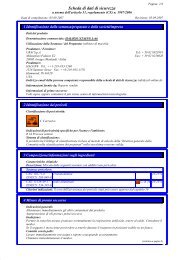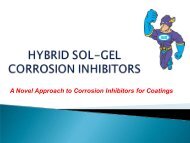The Efficiency of Corrosion Inhibitors - Halox
The Efficiency of Corrosion Inhibitors - Halox
The Efficiency of Corrosion Inhibitors - Halox
- No tags were found...
You also want an ePaper? Increase the reach of your titles
YUMPU automatically turns print PDFs into web optimized ePapers that Google loves.
Topics Basics <strong>of</strong> corrosion <strong>Corrosion</strong> control methods Features <strong>of</strong> corrosion inhibitors• Types <strong>of</strong> Ions, Solubility & Synergy Applying Synergy to Solve <strong>Corrosion</strong>Problems Meeting the demands <strong>of</strong> the future Concluding remarks & references
Standard Reduction PotentialsStandard Potential (V)Reduction half reaction1.23 O 2 + 4H + + 4e - 2H 2 O0.80 Ag + (aq) + e - Ag (s)0.34 Cu 2+ (aq) + 2e - Cu (s)0.0 2H + (aq) + 2e - H 2 (g)-0.44 Fe 2+ (aq) + 2e - Fe (s)Since E 0 red (Fe 2+ ) < E 0 red (O 2 )iron can be oxidized by oxygen
Basics <strong>of</strong> <strong>Corrosion</strong> Dissolved oxygen in water usuallycauses the oxidation <strong>of</strong> iron Fe 2+ initially formed can be furtheroxidized to Fe 3+ which forms rust,Fe 2 O 3 .xH 2 O Oxidation occurs at the site with thegreatest concentration <strong>of</strong> O 2
Galvanizing to Prevent <strong>Corrosion</strong>
<strong>Corrosion</strong> ControlMethods
<strong>Corrosion</strong> Control Methods Protective Coatings (92%)• Organic – Paint, Varnishes, Coal tar• Metallic – Galvanizing, Electroplating• Conversion – Phosphate, Chromate <strong>Corrosion</strong> Resistant Materials (6-7%)• Alloys, Plastics, Composites, Glass <strong>Corrosion</strong> Inhibitor Additives (1-2%)• Chemical – Inorganic, Organic, Mixtures
Features <strong>of</strong> <strong>Corrosion</strong><strong>Inhibitors</strong>
FeatureTypes <strong>of</strong> ions Solubility Purity / ModificationMorphologyPigment PolymerInteractionMoisture contentPVC <strong>of</strong> CIEnvironment(pH, Corrosive)Synergy What does it Influence?Protective film formedLeaching, blistering, protecting abilityProtective film, blistering, corrosionDispersion, film formation, water transmissionLong-term stability, accelerated cross-linking,catalytic effects on cureAccelerated cure, decreased corrosion resistanceGloss, film formation, blisteringSolubility, efficiency <strong>of</strong> pigmentProtective mechanisms
Ionic types: ComparisonRef # Trade Name Chemistry/IonsP1 Zinc Chromate Zinc ChromateP2 Butrol 23 Barium MetaborateP3 Shieldex Calcium Silica GelP4 Cotrol 18-8 Amino CarboxylateP5 HALOX BW-111 Barium PhosphosilicateP6 K-White 105 Aluminum TriphosphateP7 Heucophos ZPZ Modified Zinc Phosphate
Pigment Extracts Chosen to StudyPigments Protective Ability Leaching 1 g <strong>of</strong> each (sparinglysoluble) pigment in 500 ml <strong>of</strong> 0.5 MNaCl for a period <strong>of</strong> 24 hrs Mixture is filtered and pH &conductivity <strong>of</strong> the extracts ismeasured Substrates was submerged inelectrolyte for 16 hrs (steady-state) Polarization experiments conductedusing the extract solutions over CRSand zinc substrates Fresh electrolytes (0.5 M NaCl) areused each time for the anodic andcathodic polarization scansElectrolyteCounter electrodeCellSubstrateElectricContact
<strong>Corrosion</strong> <strong>Efficiency</strong> on CRSWhere:i 0= <strong>Corrosion</strong> rate inabsence <strong>of</strong> corrosion inhibitori I= <strong>Corrosion</strong> rate inpresence <strong>of</strong> corrosion inhibitor
<strong>Corrosion</strong> <strong>Efficiency</strong> on CRSRef #E corr(mV vs SCE)Rp(kΩ)i corr(µA/cm 2 )% Inhibition<strong>Efficiency</strong>Blank -639 0.21 ± 0.07 76 ± 7-P1-5781.20 ± 0.1713 ± 383P2-5450.60 ± 0.0234 ± 155P3-5521.23 ± 0.0721 ± 172P4-5500.74 ± 0.0931 ± 159P5-5030.90 ± 0.1125 ± 367P6-5490.95 ± 0.0518 ± 276P7-5853.37 ± 0.424 ± 195DECREASING CORROSION EFFICIENCY:P7 > P1 > P6 > P3 > P2, P4, P5Best Performer = Modified Zinc Phosphate
Anodic & Cathodic Polarizations oncold rolled steel (CRS)more nobleLess currentmore nobleLess currentANODICCATHODICDECREASING CORROSION EFFICIENCY:P7 > P1 > P6 > P3 > P2, P4, P5Best Performer = Modified Zinc Phosphate
Anodic & Cathodic Polarizationson zinc substratesANODICCATHODICDECREASING CORROSION EFFICIENCY:P1 >> P7 > P3 > P6 >> P2, P4, P5Best Performer = Zinc Chromate
Applying Synergy toSolve a <strong>Corrosion</strong>Problem
Cut-Edge <strong>Corrosion</strong> Inhibition Cut edge corrosion is most commonfailure mechanism <strong>of</strong> organic coatedgalvanized steel (HDG) Strontium chromate is generally used insteel primers to mitigate this Synergy <strong>of</strong> non-toxic corrosion inhibitorshas been found to perform equal tochromate
Cut-Edge <strong>Corrosion</strong> InhibitionModel Cell for Measurement <strong>of</strong> galvanic corrosion current betweenZinc and Mild steel
Artificial Rain Water (pH 4.5)
Results <strong>of</strong> Galvanic CurrentMeasurements
Observations All inhibitive pigments decreased thegalvanic currents more than the blank Blank: Current dropped from 12 to 9 µA SrCrO 4 : Current dropped to 0.2 µA Other individual pigments were down to4.5 µA Synergistic pigments had better currentsuppression; down to 1.1 µA
Meeting the Demands<strong>of</strong> the Future
<strong>The</strong> Future <strong>The</strong> future is “Green” Technology – No heavy metals! OSHA PEL Proposed 5 µg/m 3 for Cr 6+ in workplaces Feb27, 2006. OSHA ordered to promulgate new PEL.(aerospace PEL now 20 µg/m3) End-<strong>of</strong>-Life Vehicle (EU Directive 2000/53/EC): Cr 6+ , Pb,Cd, Hg banned from vehicles marketed after July 1, 2003 California Air Resources Board (CARB) approved anAirborne Toxic Control Measure (ATCM) for Emissions <strong>of</strong>Cr 6+ and Cd from Motor Vehicle and Mobile EquipmentCoatings (Automotive Coatings) September 21, 2001. Registration, Evaluation and Authorization <strong>of</strong> Chemicals(REACH) – Authorization <strong>of</strong> chemicals causing cancer,mutations, reproductive problems, or are bioaccumulativein humans & the environment
Demand for High Performance<strong>Corrosion</strong> <strong>Inhibitors</strong>Thin FilmsClear CoatsTemporaryCoatingsGreenTechnologiesCoil coating5-10 µmWash Primer10-15 µmConversionCoatings1-3 µmWaterborneLacquers2-10 µmRustPreventative5-20 µmZero VOCLow VOC<strong>Corrosion</strong>PreventingCompoundsUVPowder100% solidsHigh solidEpoxyAcrylicUrethaneAlkyd
<strong>The</strong> Future Chromate-free Heavy metal-free Sub-micron anticorrosive pigments Smart coatings (e.g. corrosion sensing) Nanotechnology
Smart Coatings
NanotechnologyWATERBORNE ACRYLICGalvanized – 336 hrs Salt Spray – 2.0 – 4.0 µm thick
Concluding Remarks Electrochemical methods can be used tostudy the efficiency <strong>of</strong> corrosioninhibitors Many factors influence the behavior andefficiency <strong>of</strong> corrosion inhibitors <strong>The</strong> future is “Green” New technologies such as SmartCoatings and Nanotechnology will soonemerge
“Bust the Rust”Thank You All !!
ReferencesSlide #Source12-17 Thierry et al – Progress in Organic Chemistry(25) 339-355 (1995)21-23 Scantlebury et al - Journal <strong>of</strong> ElectrochemicalSociety 148 (8) 293-298 (2001)29 Calle et al – <strong>Corrosion</strong> Technology Lab NASAKennedy Space Center



